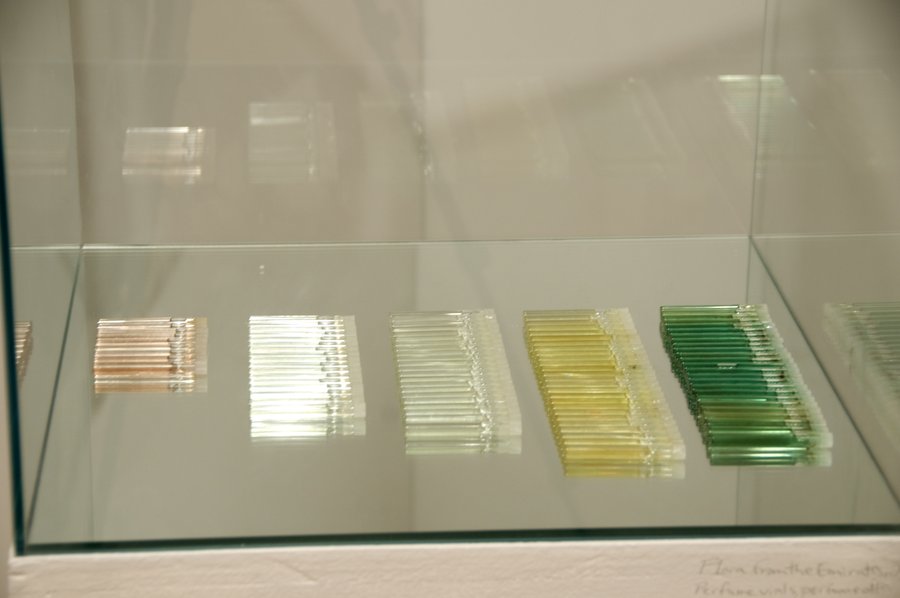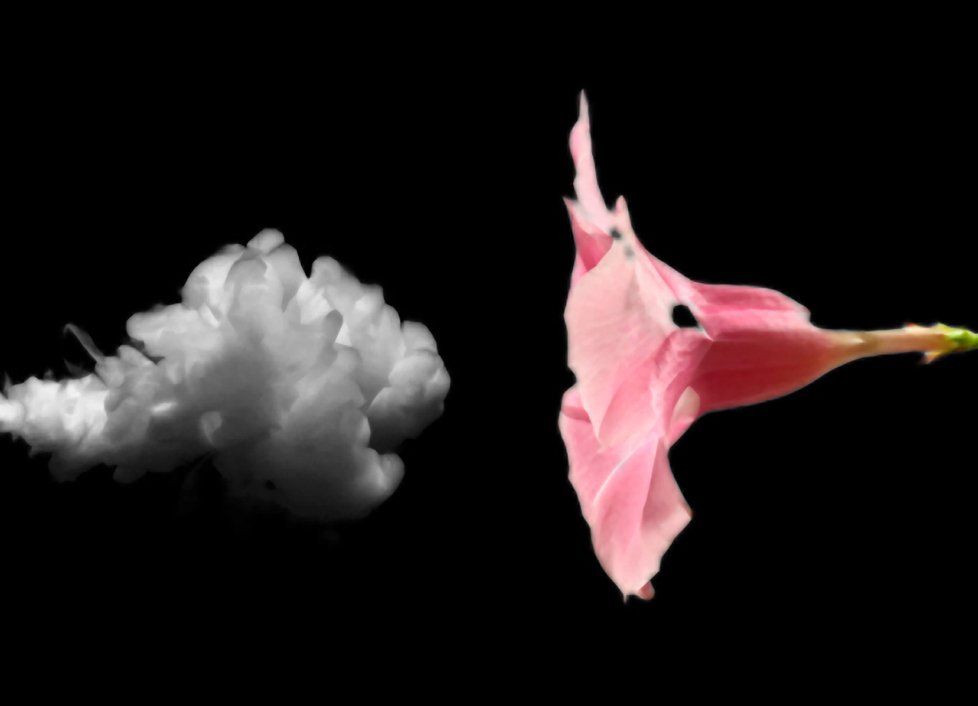Following the Lure of the Scent
(Exploring the Power of Fragrance)
De Luca Fine Art Gallery
The Lure, artist Janet Bellotto’s exhibition at the De Luca Fine Arts Gallery, intellectually engaging in the infinite number of ideas that it conjures up, is at its very root, sensuous, seductive, and romantic, albeit in a self-contained and carefully orchestrated manner. That is, despite the traditionally feminine thematic elements of flowers and perfumed fragrances inherent in the work, the Dubai/Toronto-based artist displays not one ounce of sentimental gush or sappiness. An experimental artist at heart with a bent towards the natural and social sciences, she excludes no method or persuasion – a characteristic that Bellotto is well known for – to get to the heart of the matter. In this 2011 exhibition, using video, sculpture, and photography, the artist takes a cubistic approach to explore the subject of scent from a great many angles.
 Bliss or Torture, 2011, 36 x 36 inches, lenticular photograph
Bliss or Torture, 2011, 36 x 36 inches, lenticular photograph
Effectively curated by gallery director Corrado DeLuca, The Lure begins in the street-facing front window of the gallery with a large, mysteriously intoxicating blood-red circular photograph of a bouquet of red roses titled Bliss or Torture (2011). Like other works of Bellotto’s on display, it seems to be alive and moving. The eye-fooling trick here is the artist’s use of a lenticular printing process, a technology in which a special lens produces layered images which create an illusion of depth which allows the image, the bouquet of roses in this case, to flip back and forth when being viewed from different angles. Like temptation itself, Bliss or Torture, is both inviting and portentous – a point the artist successfully entertains in other of works on view.
 Flora from the Emirates, 2009, 24 x 24 inches. Perfume vials, perfume oil. Complete Set
Flora from the Emirates, 2009, 24 x 24 inches. Perfume vials, perfume oil. Complete Set
While the beauty of Lure appeals to the bodily senses — visual first, then olfactory — at its core, the exhibition’s conceptual nature requires thought and contemplation, for each flower-based work is a receptacle of the artist’s ideas. It is also, for those that elect to take the course, it is also a study of flowers — red and white roses, white narcissus, dandelions, deadly nightshades, and daffodils — as metaphors for the power of fragrances to cite history, trigger memory, and awaken our emotions. Bellotto also hints, not too subtly I might add, of her own experience with the “clouds of scent that follow many people,” as well as the aromatic aromas infusing the air in perfume parlors that are predominant in the United Arab Emirates — Dubai in particular — where she co-chairs and teaches in the Department of Art and Design at Zayed University.
 The Grass is Greener, 2011 12 x 6 x 5 inches India Ink, perfume oil, glass
The Grass is Greener, 2011 12 x 6 x 5 inches India Ink, perfume oil, glass
Entry to Lure is The Grass is Greener (2011), a blown glass shell-shaped sculpture filled with grass-scented oil, colored black by the addition of india ink, the very oil, as the artist informed me, that instigated this project. “The smell of the oil reminded me of cut grass, something not usually found in the desert climate of the Emirates.” Further embracing the sense of smell is Bellotto’s Flora from the Emirates (2009), a museum-type vitrine lined with vials of perfumed oils. “I began collecting various perfume oils that reminded me of nature – or nature-filled moments that I could not experience in the UAE. The purpose of putting them on display this way was to create another picture of the flower, a visual transition through the colors of the scents.” Indeed this is exactly what happened. In “viewing” the vials, each with its own color and fragrance – grass, saffron, rose, jasmine, and oud, whose smell is reminiscent of a damp forest wood – I found myself trying to visualize, and actually succeeding with the more familiar– the flowers, grass, and plants – that the oils were extracted from.
 Flora from the Emirates, 2009, 24 x 24 inches. Perfume vials, perfume oil, detail of Complete Set
Flora from the Emirates, 2009, 24 x 24 inches. Perfume vials, perfume oil, detail of Complete Set
In Floral Façade (2011), four facemasks on paper with perfumed essence, Bellotto has fashioned a series to fool the eye, nose and mind, not unlike various species of insect-eating plants using these same elements of form, color, and smell, to mask their imminent danger. Like unsuspecting insects, one is drawn to the beauty of the flowery masks; on closer inspection, however, their beauty turns horrific as it slowly occurs to us that each mask, deliberately camouflaged with an enticing design, is used solely to enable the wearer to breathe, not only easier, but sometimes, to breathe at all. Mirror of Opposites and Envy, the smallest and simplest of the masks, half-face masks, in fact, are the type used to filter the air for asthmatics and others with respiratory problems. The most ghastly of the group – ironically the most compelling in size, shape and design – are Weeds of Dreams and Deadly Bed of Roses, full-face gas masks worn by fireman and soldiers at war.
 Weed of Dreams, 2011, 23 x 30 inches. Archival pigment print, per¬fume essence on Arches paper
Weed of Dreams, 2011, 23 x 30 inches. Archival pigment print, per¬fume essence on Arches paper  Deadly Bed of Roses, 2011, 23 x 30 inches. Archival pigment print, perfume essence on Arches paper
Deadly Bed of Roses, 2011, 23 x 30 inches. Archival pigment print, perfume essence on Arches paper
In The Niche of Your Hair (2011), a literary-based wall installation, Bellotto, whose hair is down to her waist – perhaps like many coifs in the Emirates, is even perfumed – makes use of the peineta, a large decorative comb usually worn under a mantilla or laced covering, as a metaphor relating the scent and flow of perfume and its romanticism to that of hair. Each of the seven acrylic peinetas on view, all intricately designed and laser cut by the artist contain words taken from the title of a poem or body of poems discussing perfume. Here the romantic sonnets of Baudelaire, Shakespeare, and others serve her well. In one peineta, Bellotto, in a bow to the multibillion dollar cosmetic industry, uses the words Montezuma Red, the color of the lipstick that Elizabeth Arden created for women in the armed forces during World War II to match the red on their uniforms.
 Blow, 2011 Digital video, appropriated footage
Blow, 2011 Digital video, appropriated footage
The two most mesmerizing works in the exhibition – due to their cinematic beauty – are her digitally manipulated videos The Lure and Blow (2011). In each one-minute piece, assembled from internet-appropriated footage looped to run continuously, she manages, without wandering too far from her exploration of perfumed fragrances and the olfactory sense, to link the visuals’ to the viewer’s own breathing patterns; and perhaps, if one’s imagination allows – as mine did – to one’s sexual responses. In Blow, a row of Narcissus, lined up like dancing chorus girls at the skirt of the stage, performing nature’s dance. They first appear as buds, then, like the shooting fireworks of an orgasm, they explode violently into bloom. The Lure pits two contrasting elements, a large, wavering pink flower and billowing puffs of smoke, face to face. Just as in life, Bellotto leaves it up to us to determine whether or not we are watching a kind of symbolic balletic pas de duex, or a duel to the death.
The Lure, appeared at De Luca Fine Art Gallery, November 3 – 27, 2011 www.delucafineart.com
Edward Rubin

